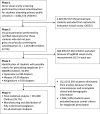A large-scale analysis of refractive errors in students attending public primary schools in Mexico
- PMID: 37598286
- PMCID: PMC10439951
- DOI: 10.1038/s41598-023-40810-5
A large-scale analysis of refractive errors in students attending public primary schools in Mexico
Abstract
A cross-sectional, retrospective study was conducted from September 2013 through July 2014 to determine the prevalence of refractive errors among students attending public primary schools in Mexico. Among 3,861,156 students at 14,566 public primary schools in all 32 states of Mexico, teachers identified reduced visual acuity in 1,253,589 (32.5%) using visual acuity measurement. Optometrists confirmed 391,498 [31.2%, mean (SD) age: 8.8 (1.9) years; 204,110 girls (52.9%)] had refractive errors using visual acuity measurement and noncycloplegic static retinoscopy. Among 288,537 (72.4%) of children with previous eyeglasses usage data reported, 241,505 (83.7%) had uncorrected refractive errors. Before prescription eyeglasses were provided, 281,891 students (72%) had logMAR visual acuity ≤ 0.2; eyeglasses corrected vision loss in 85.6% (n = 241,352) of them. Simple myopic astigmatism was the most frequent refractive error (25.7%, n = 100,545). Astigmatism > - 1.00 diopters was present in 54.6% of all students with ametropia. The anisometropia rate based on spherical equivalent difference between right and left eye ≥ 1.50 diopters was 3.9% (n = 15,402). Uncorrected refractive errors are an important issue in primary school students in Mexico. An updated study is needed to analyze the evolving trends over the past decade.
© 2023. Springer Nature Limited.
Conflict of interest statement
K.A.E. was a paid consultant of VBAM during this study; the remaining authors declare no competing interests.
Figures
References
-
- GBD 2019 Blindness and Vision Impairment Collaborators; Vision Loss Expert Group of the Global Burden of Disease Study Causes of blindness and vision impairment in 2020 and trends over 30 years, and prevalence of avoidable blindness in relation to VISION 2020: The Right to Sight: an analysis for the Global Burden of Disease Study. Lancet. Glob. Health. 2021;9:e144–e160. doi: 10.1016/S2214-109X(20)30489-7. - DOI - PMC - PubMed
-
- GBD 2019 Blindness and Vision Impairment Collaborators; Vision Loss Expert Group of the Global Burden of Disease Study Causes of blindness and vision impairment in 2020 and trends over 30 years, and prevalence of avoidable blindness in relation to VISION 2020: the Right to Sight: An analysis for the Global Burden of Disease Study. Lancet. Glob. Health. 2021;9:e144–e160. doi: 10.1016/S2214-109X(20)30489-7. - DOI - PMC - PubMed
MeSH terms
LinkOut - more resources
Full Text Sources
Medical
Miscellaneous



